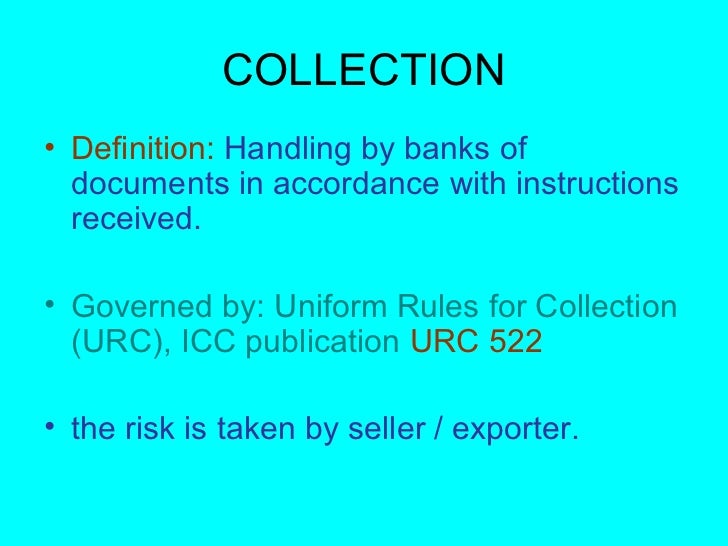Documentary collection (D/C) is a payment method in international trade. Documentary collection is also known as Cash Against Documents...
Documentary collection
(D/C) is a payment method in international trade. Documentary
collection is
also known as Cash Against Documents (CAD) by most exporters and importers.
also known as Cash Against Documents (CAD) by most exporters and importers.
- Documentary collections are less complicated than letters of credit. Also documentary collections are less expensive comparing to letters of credit transactions.
- Importers normally pay for the goods after shipment. Sometimes importers pay after they receive the goods. Such as 30 days after receipt of the goods.
- The title of goods belong to the exporter until exporter is paid by the importer. But exporter must be very creful with land, rail and air shipments as title to the goods can not be controlled under these shipments. Importers may receive the goods with or without payment under land, rail and air shipments.
- Although banks play an essential role in documentary collections, they neither check or verify the documents nor take any risks.
Documentary
collections are governed by the Uniform Rules for Collections, 1995
Revision, ICC Publication No. 522, shortly known as URC 522.
Documentary collection rules, URC 522, published by International
Chamber of Commerce, ICC. URC 522 will only be effective if it is
incorporated into the text of the "collection instruction". Collection instruction is one of the key consept in documentary collections as a result we better have close look at it on this page.
What is a collection instruction :
Collection
Instruction is a written and seperate document in which exporter should
supply to his bank along with the commercial and financial documents. Collection instructions are written in a cover letter format and normally should contain below points.
- Governing rules for the collection : As an example “This collection is subject to The Uniform Rules for Collections, 1995 Revision, ICC Publication No. 522.”.
- Details of the bank from which the collection was received including full name, postal and SWIFT addresses, telex, facsimile numbers and reference.
- Details of the principal including full name, postal address, and if applicable telex, telephone and facsimile numbers.
- Details of the drawee including full name, postal address, or the domicile at which presentation is to be made and if applicable telex, telephone and facsimile numbers.
- Details of the presenting bank, if any, including full name, postal address, and if applicable telex, telephone and facsimile numbers.
- Total amount and currency of the documentary collection.
- Documents to be supplied : URC 522 rules of the documentary collections defines two main types of documents; financial documents and commercial documents.
Financial Documents :
Financial documents means bills of exchange, promissory notes, cheques,
or other similar instruments used for obtaining the payment of money.
Commercial Documents :
Commercial documents means invoices, transport documents, documents of
title or other similar documents, or any other documents whatsoever, not
being financial documents
- How many number of originals and copies of each document supplied
- Conditions for release of documents
Documents Against Payment (D/P):
Documents may be released only if the importer makes immediate payment
according to the contracted agreement between the exporter and the
importer. Also known as sight collection.
Documents Against Acceptance (D/A):
Documents may be released only if the importer accepts the accompanying
draft, thereby incurring an obligation to pay at a specified future
date. In this arrangement the exporter is exposed to the credit risk of
the importer and the political risk of the country. Also known as a term collection.
It
should be noted that the party preparing the collection instruction
should have to clearly define how documents should be handed over to the
drawee. If instructing party fails to do so they will be liable for any
consequences arising therefrom.
- Charges : Charges to be collected, indicating whether they may be waived or not and who is going to pay for charges in detail.
- Interest : Collection of interest is a very rare case in documentary collections but if applicable, colection instruction should indicating whether it may be waived or not, with following information :
a. rate of interest
b. interest period
c. basis of calculation (for example 360 or 365 days in a year) as applicable
- Method of payment and form of payment advice.
- Instructions in case of non-payment, non-acceptance and/or non-compliance.














